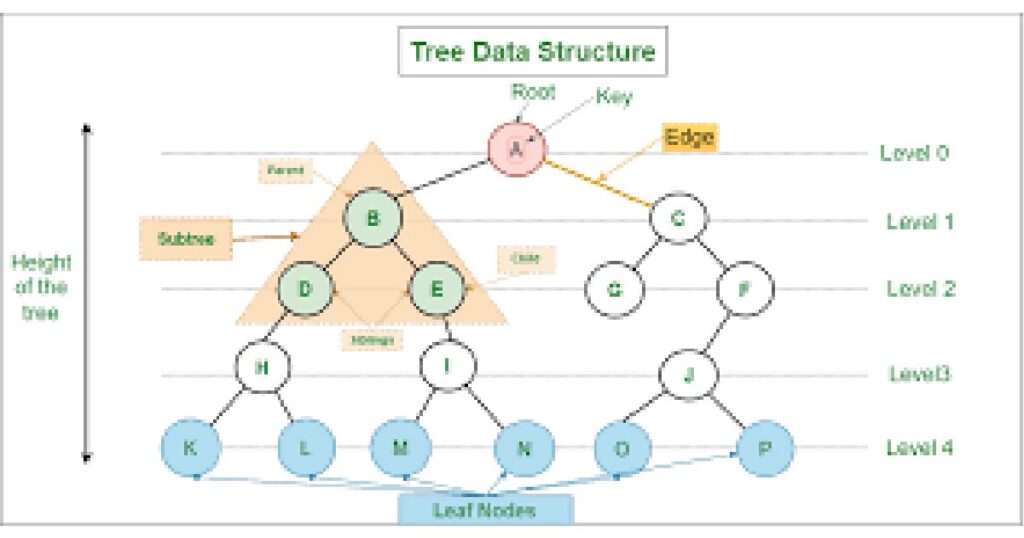Introduction
Data structures play a crucial role in software development, as they enable high-performance applications to handle large volumes of information with precision and speed. As demand for skilled professionals in designing and implementing robust data structures continues to grow, understanding data structures is essential for aspiring software engineers and developers. In the competitive tech hiring process, data structure interview questions are essential because they gauge a candidate's aptitude for coding, analytical thinking, and problem-solving.
Effective responses to data structure interview questions involve practicing, customizing solutions to preferred languages, understanding time and space complexity, being familiar with basic data structures such as arrays, linked lists, stacks, queues, trees, graphs, and hash tables, and getting feedback and learning from mistakes. By following these steps, one can tackle any data structure interview questions in 2024 with confidence and proficiency.
Understanding Data Structures
Data structures are essential in computer science and software development, providing a systematic way to organize, store, and manipulate data. They enable efficient operations, optimize memory usage, facilitate problem solving, enhance scalability, and improve code maintainability. Data structures include arrays, linked lists, stacks, queues, trees, graphs, hash tables, heaps, and directed acyclic graphs. Data structure interview questions assess problem-solving skills by evaluating analytical thinking, algorithmic design, time and space complexity analysis, critical thinking, and creativity.
These data structure interview questions assess candidates' ability to break down complex problems into manageable components, design efficient algorithms using appropriate data structures, and analyze time and space complexity. Understanding data structure interview questions emphasizes the useful application of data structures in solving challenging problems and helps candidates not only land job offers but also acquire the skills needed to succeed in real-world software development scenarios.
Preparation Strategies for Data Structure Interviews

Data structure interviews are essential for software developers and engineers to showcase their technical prowess and problem-solving abilities. Common interviewing techniques include understanding the problem, clarifying doubts, discussing your approach, writing clean and readable code, testing your code, optimizing, and explaining your solution. Data structure proficiency requires regular practice, comprehension of time and space complexity, mastery of the fundamentals, problem-solving skills across a range of scenarios, thinking aloud, learning from errors, and keeping up with industry trends.
Websites such as LeetCode, HackerRank, and Coursera, books like "Introduction to Algorithms" and "Cracking the Coding Interview," blogs and online tutorials, coding communities, simulated interviews and coding challenges, and instructional YouTube channels are some of the resources available for in-depth data structure study. By adopting these techniques into your preparation routine, you'll be ready to approach data structure interviews with competence and assurance. Remember that the secret to success is practice and a firm grasp of the principles.
Common Data Structure Interview Questions

Q1. What are data structures?
This is one of the typical data structure interview questions to prepare for. Data structures are techniques or concepts that are used to systematically and efficiently manipulate data. They are best used in data management, compiler design and to analyze numbers.
Q2. How are data structures different from file structures?
This is also one of the frequently asked data structure interview questions. On one hand data is stored with standard policies on drives or storage devices for file structures and on the other hand, data is stored on RAM and disks with customized policies.
Q3. What are the main classifications of data structures?
This is also one of the must-know data structure interview questions. There are 2 main categories or types of data structures, and these are primitive and non-primitive data structures. Primitive data structures are simplest forms and operate directly upon machine instructions. Non primitive on the other hand are defined by the programmer and are implemented using primitive data types. They are further divided into two groups; linear (linked list, array, queue, stack) and non-linear (graph, tree) data structures.
Q4. What is an array and how do you access an element in an array?
An array is a linear data structure which is a collection of elements or data types, identified by an index and stored in contiguous memory locations. Elements in an array can be accessed by using their index or key.
Advanced Data Structure Interview Questions
Q5. What are linked list data structures?
This is one of the data structure interview questions that you have to delve a little deeper into. Also a linear data structure, linked lists consist of nodes each containing a data element and reference or link to the next node in sequence. Pointers are used to link the nodes or elements to form a chain and the entry point is known as a head. Linked lists are dynamic structures in that they allow for dynamic sizing and elements in the linked lists cannot be accessed randomly with index rather you need to traverse the list to reach the targeted element. There are several types of linked lists including singly, doubly, and circular linked lists. They are efficient and mostly used for insertion and deletion operations.
Q6. What are the types of data structure trees?

There are many types of data structure trees, each with its own application and special characteristics. They are non-primitive and non-linear data structures used to represent the relationship between data elements in a hierarchical manner. The most common types of data structure trees are binary tree, AVL tree, Red-Black tree, Binary search tree, general tree and Trie among others. In order to optimize the performance of algorithms and data manipulation tsks, choosing the right tree is essential.
Q7. Explain what graph data structures are.
Graphs are non-primitive and non-linear types of data structures that are commonly used in most fields of science such as chemistry, physics and mathematics or in social networks, transportation networks or recommendation systems. They are used to represent the different types of physical design structures and consist of vertices that are connected by edges which can be directed. Graphs can be directed or undirected. Graphs are normally used to represent the relationship between different entities. They can be represented in diverse ways including the adjacent matrix, edge list and adjacent list.
Algorithm-Specific Data Structure Interview Questions
Q8. What are sorting algorithms?
A collection of items or data can be arranged in a particular order using a set of algorithms or procedures called sorting algorithms. Putting the elements in either ascending (increasing) or descending (decreasing) order is the aim of a sorting algorithm. Sorting algorithms include bubble sort, insertion sort, selection sort, shell sort, heapsort, radix sort and comb sort among others. Regarding time and space complexity, and stability (i.e., whether it preserves the relative order of equal elements), each sorting algorithm has advantages and tradeoffs of its own. The size of the dataset, the type of data, and the particular needs of the application all play a role in the algorithm that is selected.
Q9. What are the types of complexities in data structure?
Data structure interview questions such as this require in-depth explanation. Searching algorithms are essential in various applications, including web information retrieval and database queries. They are used to find a specific target item within a collection of data. The following are examples of common algorithms: hashing, depth-first search (DFS), breadth-first search (BFS), jump search, exponential search, binary search, and interpolation search. A simple algorithm known as "linear search" loops over each element in a collection to see if it matches the target item. By halving the search interval until the target item is located, binary search is an effective algorithm for locating a target item in a sorted collection. Based on the value of the target as well as the maximum and lowest values in the array, an interpolation search determines the target item's position. Jump search divides the array into smaller blocks first, while exponential search expands until the target item is found. Hashing converts the target item into a hash value for quick lookups, such as in database indexing.
Q10. What are some of the optimization techniques used in data structures?
- Greedy algorithm
- Dynamic programming
- Use of data structures
- Memorization
- Optimizing loops
- Parallelization
Q11. What are the types of complexities in data structure?
The analysis of the performance of operations on a particular data structure is referred to as data complexities. Time and space complexity are the two primary categories of complexity. The term "time complexity" describes how long an algorithm takes to finish depending on how big the input data is. Common notations for time complexity include O(1), O(log n), O(n), O(n), O(n^2), O(n^2), and O(2^n). The term "space complexity" describes how much memory an algorithm requires in relation to the volume of the input data. To analyze and design effective data structures and algorithms that take into account variables like input size, available memory, and required execution speed, both complexities must be understood.
Q12. What operations can be performed on queues?
- Enqueue
- Dequeue
- Peek/Front
- Init
- IsEmpty
- Rear
Q13. Where can stack data structure be used?
The stack data structure is a versatile tool in computer science and software development that uses a Last In, First Out (LIFO) order of operations. Function call management, expression evaluation, balancing symbols, undo operations, browser histories, backtracking algorithms, parsing and compilation, memory management, undo in text editors, forward and backward navigation buttons in web browsers, algorithm implementations, and postfix notation are just a few of the scenarios and applications in which it finds use. Stacks are essential for managing function call frames and local variables in computer memory, ensuring syntactical correctness, and maintaining the state of the compiler. It is also used in backtracking algorithms and postfix notation to evaluate
Q14. How do hash tables work in data structures?
A hash table is a data structure that uses hashing to store and retrieve data quickly. To find the index where the data is stored, it employs a hash function to return a hash code or hash value. Next, modulo arithmetic is used to map the hash code to an index in the hash table. When more than one key yields the same index, a collision resolution technique is used to store the data at the designated index. The hash table looks for the data in the corresponding slot after calculating the index for the given key using the same hash function. The load factor measures the size of the hash table, and dynamic resizing is often used to maintain performance. Hash tables are frequently used in computer science and software development because they are effective for providing rapid access to data based on a key.
Q15. What is the importance of designing custom data structures in software development?
Custom data structures are crucial in software development for several reasons. Customized solutions, enhanced operations, memory effectiveness, sophisticated data modeling, algorithmic efficiency, security, domain-specific needs, adaptability, decreased redundancy, and a competitive edge are all made possible by them. Data can be stored, retrieved, and altered more effectively with these structures since they can be customized to meet the needs of particular applications. They can also minimize memory usage and wastage, work in harmony with specific algorithms, and provide security measures for sensitive data. They can also be flexible and extendable, making them easier to adapt to changing requirements or extend functionality in the future. Ultimately, custom data structures provide a competitive edge in the market, leading to better performance, faster response times, and a more efficient user experience.
Q16. What are some key factors to consider when selecting a data structure for a high-traffic web application?
Consider aspects like time complexity, memory efficiency, concurrency and thread safety, cache efficiency, persistence, scalability, complexity of operations, data access patterns, domain-specific requirements, consistency and availability trade-offs, error handling and resilience, monitoring, and profiling when selecting a data structure for a high-traffic web application. Select structures that optimize memory usage, guarantee concurrency and thread safety, optimize cache locality, optimize time complexity for operations, and take persistence options into account. Scalability is essential for managing big datasets and high volumes of concurrent requests. Examine the intricacy of the processes involved, take into account data access trends, and take into account domain-specific needs. Select data structures with robust error-handling mechanisms and strong consistency (or eventual consistency). Continuously evaluate the performance of the chosen data structures to identify potential bottlenecks or areas for optimization.
Q17. How do data structures like heaps or priority queues relate to database operations?
Questions like this make up the advanced data structure interview questions. Data structures like heaps and priority queues are crucial in database operations for efficient data management and retrieval. They are used in query optimization, top-K queries, indexing, aggregation, resource allocation, task scheduling, concurrency control, job queues, and handling complex queries. They help select and execute the most efficient query plan, ensuring efficient data retrieval based on specific criteria. They are also used in aggregation functions like MIN, MAX, SUM, and AVG. Priority queues can be used for task scheduling and deadlock prevention, implementing concurrency control mechanisms, and managing job queues. They can also be used to implement algorithms like Dijkstra's algorithm for finding the shortest path in a weighted graph. Overall, these data structures are essential for efficient database operations.
Q18. You are designing a routing table for a router in a large network. How would you use data structures to efficiently store and retrieve routing information?
This is one of the technical data structure interview questions that requires practical experience. The Trie data structure, which is a popular choice for large networks to store and retrieve routing information is what I will use. This tree-like structure, where each node represents an IP address, allows for fast lookups based on destination addresses. The Trie structure includes a prefix, next hop, and child pointers. To insert a route, I will traverse the tree based on the network prefix, create nodes, and update the next hop information. To retrieve the next hop, I will start at the root and follow the destination address. The Trie structure handles Longest Prefix Match (LPM) efficiently. I will then use Memory optimization techniques like Trie compression to reduce the Trie's memory footprint. Updating or deleting routes follow the same steps as insertion, and error-handling mechanisms can handle improper formatted routes or conflicts so that is what I will do next.
Q19. How do you demonstrate your problem-solving skills through behavioral interview questions
To effectively demonstrate problem-solving skills in behavioral interviews, it is essential to understand the problem, identify relevant data structures, describe your thought process, provide a clear explanation, discuss time and space complexity, trade-offs, address edge cases, walk through an example, highlight past experiences, discuss lessons learned, and maintain composure. You can effectively demonstrate your problem-solving abilities by understanding the problem, choosing the best data structure, explaining your reasoning, giving a clear explanation, talking about trade-offs, addressing edge cases, giving examples, highlighting prior experiences, talking about lessons learned, and remaining composed. Your ability to apply knowledge in real-world scenarios is evaluated by behavioral questions, and demonstrating your proficiency with data structures for problem-solving will assist you in overcoming real-world obstacles.
Q20. How do linear data structure and a hierarchical data structure differ from each other?
This makes up the last question on our data structure interview questions list. Although they describe the relationships between data points, hierarchical and linear data structures differ in how the data interacts. With linear data structures, data is arranged in a single-level sequence like arrays, linked links, queues, and stacks. On the other hand, with hierarchical data structures, data is organized in complex settings such as graphs, file systems, and trees.
Conclusion
Acing interviews is one way to excel in the field of data structure and software development. Hence the need to adequately prepare for those interviews by mastering data structure interview questions. Your approach to the questions shows your problem-solving abilities and skills in birthing efficient and effective solutions. Candidates with a solid understanding of different data structures can approach interviews with confidence, knowing they have the skills necessary to take on challenging tasks.



